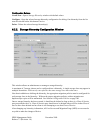Field Descriptions
Hierarchy ID. The ID associated with this hierarchy . Any unique, positive 32-bit integer value. The
default value is the last configured ID plus 1.
Hierarchy Name. The descriptive name associated with this hierarchy. The default value is “Hierarchy
<ID>”.
Top Storage Class. The storage class at the highest level of the hierarchy.
After a storage class is selected, a new storage class drop-down list will appear in the Migrate To field.
Selecting a storage class from the drop-down list will define the storage class to which the Top Storage
Class will migrate, and an arrow will show the migration path from the Top Storage Class to the second
Storage Class. .
This process may be repeated to create more migration paths.
Depending on whether the Top Storage Class is disk or tape, either one or two new storage class drop-
down lists will appear.
Migrate To. The storage class id(s) to which the a Storage Class will migrate. Initially, when creating a
new hierarchy, these fields will not be visible. As the user configures the hierarchy, the MigrateTo
values will be displayed. After a storage class has been selected from a drop-down list, the drop-down list
will be replaced with a non-editable storage class id corresponding to the user’s selection. One or more
new storage class drop-down lists will become visible.
Storage Class. The id number of the storage class at the second through the fifth level of the hierarchy.
See description above for Top Storage Class.
Storage Class Cfg button. Clicking this button will open the Storage Class Configuration window
corresponding to the storage class name to the left of the button.
6.2.3. Changing a Storage Hierarchy Definition
A storage hierarchy definition can be changed by bringing up the Storage Hierarchy Configuration
window and making the desired modifications. Note that the only modification that is possible to an
existing storage hierarchy is the inclusion of additional storage levels at the bottom of the hierarchy. All
other modifications require that the hierarchy be deleted and recreated.
When adding a migration target to the bottom of a storage hierarchy, be sure that the migrating storage
class is configured with appropriate migration and purge policies. Without migration and purge policies,
no migration and purge will take place even if target levels exist in the hierarchy. Furthermore, any pre-
existing data in the storage class (data which was written into the storage class before the storage class
was configured to use migration and purge policies) will not be migrated and purged even after the
migration and purge policies are added. The migration and purge policies are honored only for data
written after the policies are put into effect. To migrate and purge data written before these policies
became effective, use the mkmprec utility.
6.2.4. Deleting a Storage Hierarchy Definition
The rules that apply for deleting a Class of Service also apply for deleting a storage hierarchy because in
most systems a one-to-one relationship exists between hierarchies and Classes of Service. Before deleting
a hierarchy, all the files in all of the Classes of Service that use the hierarchy must be deleted. Failure to
HPSS Management Guide November 2009
Release 7.3 (Revision 1.0) 173


















